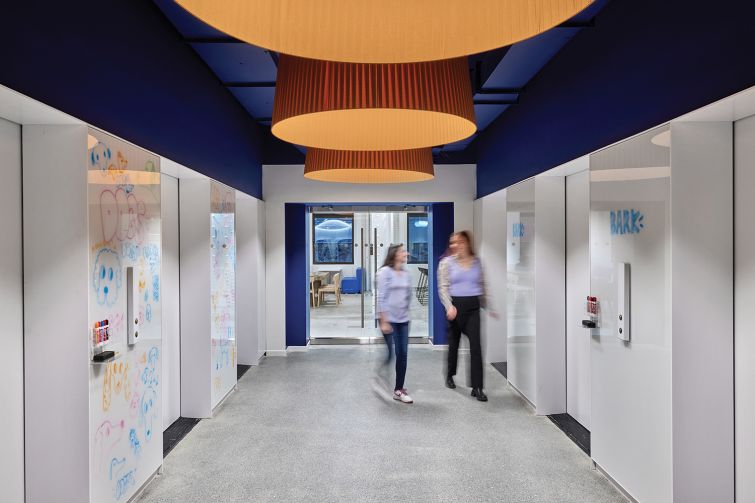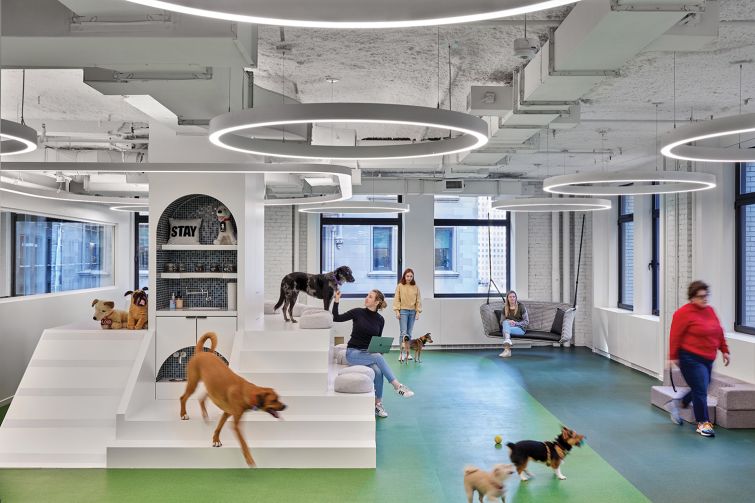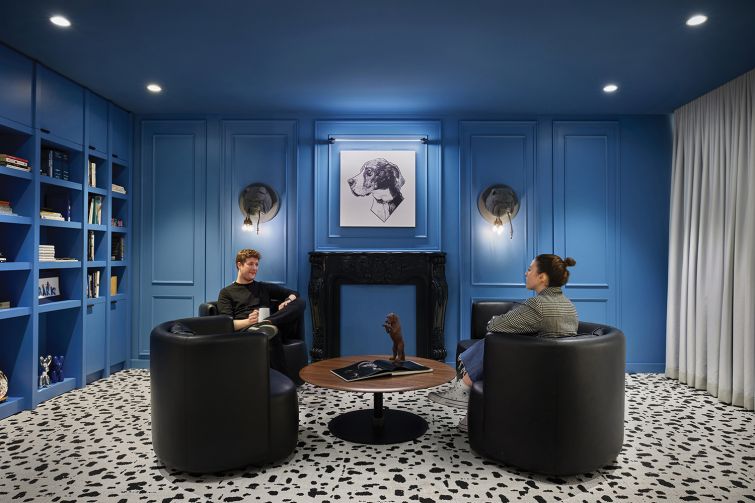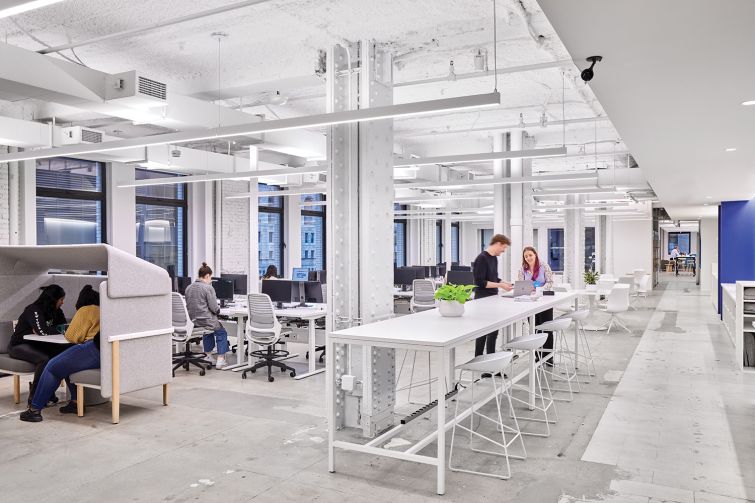How BarkBox Designed an Office Friendly to Dogs and Humans
The 120 Broadway digs include an indoor dog park complete with hiding places
By Rebecca Baird-Remba April 4, 2023 7:00 am
reprints





When subscription pet-product company BarkBox opted in late 2021 to move its offices from SoHo to the Financial District, its employees pushed for a whimsical, dog-friendly space that would be colorful, casual and fun.
“They wanted to hide 50 drawings of squirrels around the office for visitors to find,” said Lon Skidds, an architect at MKDA who worked on the project and noted that the office included themed conference rooms such as the “420 Burrito Room” and the “Pigs in a Blanket Room.”
The 52,000-square-foot spot at 120 Broadway welcomes visitors with whiteboards that they can doodle on next to the elevators and a three-dimensional BARK logo filled with dog toys. To the left is a cafe with blue leather booth seats, a kitchen outfitted in light woods, and round tables with armchairs.
“In this specific project it was about wellness for the dogs as well,” explained Edin Rudic, an interior designer at MKDA. “The choice of materials had to be cleanable, wipe-able, dog-friendly. With these tech-like spaces where there’s lots of hard surfaces, noise becomes an issue. To mitigate the noise we had to bring in absorbing soft materials such as these lamps [in the elevator lobby] and introduce them on the ceiling, not the floor.”
In areas of the office that had open ceilings, the designers sprayed sound-dampening foam on the ceiling to reduce noise.
Dog-friendly touches include a “dog park” section of the office, with a custom-built white stair platform where dogs can lie down or play, round holes for shy dogs to hide in, and a large wooden ball pit for dogs made to look like one of the company’s subscription boxes. A black-and-white houndstooth-patterned seat suspended from the ceiling offers seating for people. The dog platform also features three small, built-in sinks, two of which are low enough to be used as dog water bowls.
The main work area is a standard open office with high-top tables for group meetings and long, open benches for desk setups. Most of this space is painted gray or white, with blue accent walls. There are also large wall nooks — carved in the shape of a rectangle with a sloping top line — outfitted with blue upholstery and cushions, where dogs and people can sit, relax and work.
Two small conference rooms were designed with offbeat themes. The 420 Burrito Room — a nod to weed-themed dog toys — includes green felt walls, green lighting, green armchairs and a smiling neon pot leaf on the wall. And the Pigs in a Blanket Room next door has pink felt walls, pink lighting, yellow chairs and a neon sign meant to look like the company’s viral “big honkin’ pigs in a blanket” toy.
Next to the kitchen is another unusual room with blue wooden walls and open blue shelves full of books. There’s a fake fireplace with a black mantel, black rounded armchairs, a low wooden coffee table and a pen-and-ink portrait of a dog on the wall. The wall sconces look like bulldogs holding lightbulbs. The bookshelves can also open to reveal a small, cat-themed room (technically a mother’s room) with floral wallpaper, green armchairs and cat-themed parody paintings, including Mona Lisa as a big orange tabby. Rounding out the lounge is a blue wall of framed dog portraits and a small bar with high-top seats.
Another unusual aspect of Bark’s office are the gender-neutral bathrooms, which feature several floor-to-ceiling stalls arranged around an open sink area with round mirrors suspended from the ceiling. While the bathroom area is mostly white, one wall features a black-and-white drawing of a dog in a fire hydrant, staring at a smiling poop emoji. Skidds said that the landlord, Silverstein Properties, wanted the builders to go to the Department of Buildings and get special permission to build out the gender-neutral restrooms.
“This company did have a desire to bring that to its table for its staff,” said Skidds. “This just tells you how some companies are more progressive in the way they try to cater to Gen X, Millennials and Gen Z.”
Rebeccca Baird-Remba can be reached at rbairdremba@commercialobserver.com.



